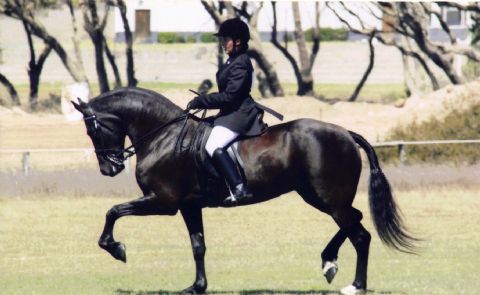Type the name of the breed you're looking for below
[wpdreams_ajaxsearchlite] Don't see the breed your're looking for? Click here and let us know!
Vlaamperd horse
| Country Of Origin | South Africa |
| History and Background | The Vlaamperd, SA Vlamperd or Vlamperd is a very rare horse breed developed in the Western Cape region of South Africa. It was a cross between the Friesian, Thoroughbred, Hackney, Cape Harness horse, and assorted heavy warmblood breeds on smaller Cape horses. In the Afrikaans language, "Vlaamperd" literally translates as "Flemish horse," in reference to its roots in the Friesian breeding of Belgium and the Netherlands. The stallions are always black, though mares may be dark brown. They are used for both riding and work in harness. In 1820, Lord Charles Somerset imported several Arabian and Thoroughbred stallions to South Africa. These stallions were crossed with local mares. The result was a riding horse originally called the Hantam horse or Cape Horse. In the early 1900s, Friesian stallions were imported to South Africa and crossed on the Hantam mares. In addition, a few East Friesian, Hackney, Oldenburg and Cleveland Bay stallions were also used. In the process, the Hantam horse became extinct as a breed, replaced by a more powerful riding horse which also was capable of harness work. Bloodlines of the Cape Harness horse were also part of the cross A major foundation sire was a stallion named Kemp, who was of East Friesan and Oldenburg breeding. Later, the stallion Scheepers, foaled in 1930, had a significant influence on the development of the Vlaamperd. While the breed was in development, the Dutch banned the export of Friesian horses to try to control the breeding of their horses. To evade the law, South Africans began to import Friesians from Antwerp in Belgium and referred to Friesians as "Vlaamse perde" or "Flemish horses." From this term came the name Vlaamperd. The Vlaamperd Breeders Society was founded in 1983 in Bloemfontein to further preserve and protect the Vlaamperd. Today the breed is small in number but is seen in the tourism and various festivals in South Africa. Some classify it as nearly extinct. It is recognized in South Africa as an independent, established breed. |
| Use Today | Pleasure riding horse, Cart horse, Riding horse, Competition horse |
| Height | 14.3 to 15.2 hands tall (57-60 inches, 145-152 centimeters) |
| Colour | Black |
| Characteristics | It is known for its fine, high motion, and excellent driving ability, making the breed popular as a harness horse, both in tourism and festivals, driven singly or in teams of up to eight horses. They are also popular as riding horses in dressage, particularly classical dressage performances. From Friesian breeding, the Vlaamperd is a very dark colour. All stallions are black, while mares are preferably black but also can be dark bay or "pale black" which is, essentially, dark bay or seal brown. Lighter colours are, however, strictly prohibited and may not be used in breeding, since this is considered a proof of undesired crossbreeding. |
| Personality and Temperament | Good disposition |



